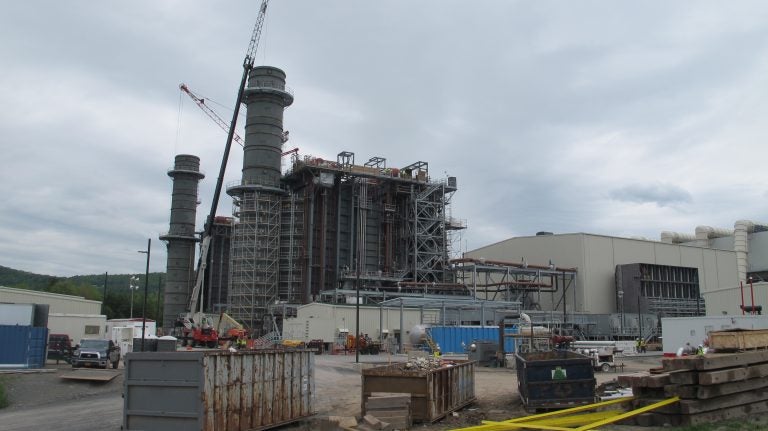PSEG plans to power down all but three natural-gas power plants
Company indicates that making the closeouts a done deal by 2046 is critical to goal of reducing climate-warming emissions to net zero by 2050.

A natural gas power plant under construction in Bradford County, Pa. (Marie Cusick/StateImpact Pennsylvania)
This article originally appeared on NJ Spotlight.
—
Public Service Enterprise Group intends to shutter all but its three of its newest natural-gas-fired power plants by 2046, a step driven by a company push to reduce climate-warming emissions to net zero by 2050.
Realizing those goals, however, depend on policy changes, like putting a price on carbon, along with technological advances, such as lower costs for energy storage and nuclear power, according to Ralph Izzo, PSEG’s CEO, president and chairman.
The announcement aligns with PSEG’s recent moves to shift away from fossil fuels by closing or selling its coal-fired units and switching to cleaner ways of producing electricity, as well as encouraging customers to use less energy.
“The science of climate change is clear, and we believe society must move beyond simply ‘heeding warnings’ to acting on them,’’ Izzo said. His company plans to reduce its carbon emissions by 80 percent below 2005 levels by 2046.
Keeping the grid out of danger
That could result in the closing of more than 6,000 megawatts of gas-fired power plants — provided policy changes and technological advances allow the company to retire the units without adversely affecting costs to consumers and reliability of the grid.
If those plants are shuttered, the remaining natural-gas units would be Sewaren in New Jersey, Keys in Maryland, and Bridgeport in Connecticut.
“If we make this transition too quickly, it will be expensive for customers, and we don’t want to do that,’’ Izzo said. “Candidly, a patchwork quilt of renewable energy state by state will not get us where we need to get rid of fossil fuels.’’
Cheap natural-gas prices created by plentiful supplies in Pennsylvania and elsewhere have cushioned some of the impact of states like New Jersey switching to cleaner but more expensive ways of producing electricity, including solar energy and offshore wind. It also has offset some of the costs of making the electric and gas grids more reliable.
Cutting off coal
At the same time, PSEG has closed its two remaining coal plants in New Jersey and sold its interest in two coal-fired plants in Pennsylvania. Further, it plans to shutter its remaining coal facility in Bridgeport in June 2021. The potential exit from the natural-gas sector accelerates that trend.
“It’s not that surprising,’’ said Paul Patterson, an energy analyst with Glenrock Associates. “There are a lot of companies out there talking about aggressive reductions in greenhouse-gas emissions.’’
With states adopting ambitious renewable-energy targets, many companies are moving toward cleaner energy, he said. “The cost is coming down, and they’d be happy to deliver that energy to customers and make a profit on it.’’
Pick up the pace
“The big missing piece is energy efficiency,’’ Izzo said, noting there is no reason why New Jersey should rank as low as 29th in the nation in helping customers reduce their electric and gas use. “We are not moving quickly enough.’’
Public Service Electric & Gas, a subsidiary, has a $2.8 billion energy-efficiency proposal before state regulators, but it appears to be stalled in a dispute over approving the program before the state adopts new regulations governing how its energy-efficiency program is structured. PSE&G is also seeking regulatory changes to remove disincentives that discourage investments in energy efficiency.
“We have for a decade been trying to solve the problem of climate change,’’ Izzo said. Public policy is not allowing it to happen, he said.
PSEG provides about 90 percent of the state’s carbon-free power from its fleet of nuclear plants, including three in South Jersey. This past April, the state approved $300 million in annual ratepayer subsidies to prevent the units in New Jersey from closing.
Those plants are projected to close beginning in 2036 and over the next 10 years, but recent modeling done by the New Jersey Board of Public Utilities anticipates they will remain open until 2050, assuming they can extend their licenses.
PSEG also has invested heavily in solar and is partnering with Ørsted, a Danish company that has won the rights to build the state’s first offshore wind farm off Atlantic City.
WHYY is your source for fact-based, in-depth journalism and information. As a nonprofit organization, we rely on financial support from readers like you. Please give today.




